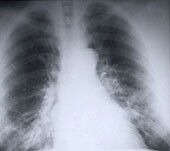- Skip Storing This Everyday Product in the Fridge Door
- Green Tea + B3 Pairing May Boost Brain Health
- Navigating Your Midlife Crisis: Embracing New Possibilities
- City Raccoons Showing Signs of Domestication
- Mapping the Exposome: Science Broadens Focus to Environmental Disease Triggers
- One Week Less on Social Media Linked to Better Mental Health
- Your Brain Changes in Stages as You Age, Study Finds
- Some Suicide Victims Show No Typical Warning Signs, Study Finds
- ByHeart Formula Faces Lawsuits After Babies Sickened With Botulism
- Switch to Vegan Diet Could Cut Your Greenhouse Gas Emissions in Half
U.S. Lung Cancer Rates Falling Overall, Study Finds


Overall lung cancer rates are dropping, according to a new analysis of nearly a half million Americans with lung cancer. But, the news wasn’t all good — the study also found that the rates of certain types of lung cancer are increasing, according to researchers from the U.S. National Cancer Institute (NCI).
Over nearly three decades, the overall lung cancer rate has dropped approximately 12 percent, said the study’s lead author Denise Riedel Lewis, an epidemiologist at the NCI.
“The good news is that lung cancer rates are declining. However, it’s not as clear for certain subtypes, and we are not exactly sure of the reasons behind these increases,” Riedel Lewis said.
Riedel Lewis said that while she cannot draw a definitive conclusion about what’s causing the decline in lung cancer rates, she can infer that it’s mostly due to decreases in smoking.
Since 90 to 95 percent of lung cancers in the United States are caused by smoking, these changes in lung cancer rates likely reflect that fewer people are smoking, she said.
One type of lung cancer that’s on the rise is called adenocarcinoma, Riedel Lewis said. Adenocarcinomas account for about 40 percent of all lung cancers, according to the American Cancer Society (ACS). They usually start in the outer part of the lungs. They tend to grow slower than other types of lung cancer and are more likely to be found before spreading outside the lung.
Dr. Norman Edelman, a senior medical advisor to the American Lung Association, said this type of cancer may be increasing as a result of changes in the way smokers smoke.
“The deeper you breathe in smoke, the more likely the cancer-causing tars are going to get into the outer area of the lungs, and that’s where adenocarcinoma starts,” he said.
The increase in adenocarcinoma may be due to people smoking low-tar, low-nicotine — so-called light — cigarettes, Edelman said. “People were inhaling more deeply and smoking more just to get the amount of nicotine they were looking for,” he said.
Recent adenocarcinoma rates were higher among young women than among men, Riedel Lewis noted.
Another type of cancer, squamous cell carcinoma, is dropping less rapidly than it has in the past, Riedel Lewis said. This type of cancer accounts for about 30 percent of all lung cancers. Squamous cell cancer affects the cells that line the airway and cells in the middle of the lungs, according to the ACS.
Small cell lung cancer rates, as well as unspecified lung cancer rates dropped, the researchers found.
Edelman pointed out that gender differences in lung cancer rates are changing. “The rates of lung cancer in men and women are converging — they are almost the same now. The rates of lung cancer in men are going down and the rates in women have plateaued.”
Edelman also noted that the rates of lung cancer had been growing among women because they took up smoking later than men, so the long-term effects of smoking were delayed compared with men. “The rate of lung cancer among women is not declining, but it will, just as it has in men,” he said.
“The fewer people who smoke, the fewer people who will get lung cancer, so we have to keep fighting the good fight,” Edelman said.
For the study, researchers collected data from more than 450,000 people diagnosed with lung cancer between 1977 and 2010. The information was part of the Surveillance, Epidemiology, and End Results (SEER) program.
Findings were published in the Aug. 11 online issue of the journal Cancer.
More information
For more information on lung cancer, visit the American Cancer Society.
Source: HealthDay
Copyright © 2025 HealthDay. All rights reserved.










